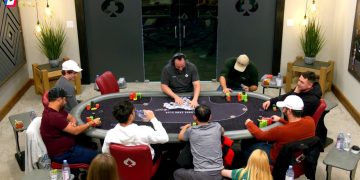When you get to the mid to late levels of a poker tournament you are going to see a lot more aggression than some might expect. You’re going to see a lot of re-raising before the flop, and that means you need to get used to the idea of the poker 3-bet.
To be fair, not everyone who throws out a 3-bet does so because he or she actually understands poker strategy. They may not understand exactly what kind of poker hand should lead to this type of betting, but they’ve seen it done in Texas Hold’em poker tournaments before so they’ll do the same.
Most players don’t understand how to 3-bet, and that’s good news for you. If you can figure out how to do it properly, you’re going to win more hands and go deeper in poker tournaments and start taking more pots in these tournaments. You’ve just got to learn how to take advantage of the hot new trend.
When we talk about a 3-bet, it’s good to specify which type we’re actually talking about. There are basically just two, and we’ll cover the value 3-bet first.
Value 3-Bets

If there’s a traditional kind of 3-betting in Texas Hold’em poker, it’s this one. This is when you throw down a re-raise because you have the best poker hand – it’s practically in the poker rules by this point, and something you’ll have to embrace as a player.
There are plenty of arguments as to what type of poker hand will actually lead to this type of betting turning into a valid poker strategy. There are always a number of variables at play, so there’s not actually a hard and fast answer at this point.
If you want to keep things simple, though, you just want to go back to one of the most important unwritten poker rules – if you have think that you have a hand that can take out your opponent’s poker range, you need to bet big.
What that means, of course, varies depending upon the person against who you are playing. If you’re playing with a tight and aggressive player, the 3-bet will usually come out when you have a preferred hand. If you’re up against a looser player, you might drop the re-raise with something that’s a little less of a sure thing.
The important thing for you to avoid, though, is getting too predictable. When you re-raise off of a really tight range, other players are going to figure out that you’ve got something of value fairly quickly. This, in turn, is going to allow them to play more efficiently against you and keep you from winning as much money.
Light 3-Betting
A light 3-bet is a specific type of poker strategy. In this type of 3-bet, you’re not actually holding the best cards – but you are holding cards that could end up as something useful later on. It’s basically a semi-bluff hand.
Your goal here is less to go on and win the pot and more to hit your opponents where it hurts and take the pot before the flop. It’s a bullying strategy to be sure, but one that works.
The use of a 3-bet can be a perfect tool for anyone who wants to balance out his or her image at the table. It’s a move that you can use to show power, but it’s also a move that you can use to make it seem like you’re a little reckless.
In short, you use this move to make people doubt their own preconceived notions about how you play in order to bring home more money when you do tighten things up.
As with a value 3-bet, you’re going to work on light 3-betting only when you have specific types of hands. Just like its more stable cousin, the light version really does depend on everything from your play position to your image at the table. You’ve just got a much wider range of hands you can use.
Since you’re not necessarily gunning to win at a showdown, you’ve got a lot of hands you can use. Your ideal move here is to win before the flop – if that doesn’t work, though, you’re going to hope that you’ve got something you can build off of as a backup.
The go-to here is usually high-ranking suited connectors. A ten and jack of spades, for example, can be a monster if things turn out right for you. You’re not shooting for the moon, but you’re putting out something that can realistically work for you.
Remember, though, that your real intention here isn’t to get as far as a showdown. If you have to go to the flop, you’re actually already playing a little bit behind. Your goal is to push out other players before they see the cards.
In short, you want them to fold.
Profitability of Folding

We generally want to look at poker in terms of making money, so we’re going to do that here. We need to know how often we need to bully out an opponent before the flop in order to make this strategy profitable.
The answer here is pretty simple, since you’re betting a re-raise. If you can get your opponent to fold two out of three times, you’re going to make money. These are really excellent odds.
Why?
Because you’re going to make money without turning cards, two out of three times. Not bad, right? If you can knock an opponent out with your three bet that often, you’re going to be going to a well that’s full of nothing but money. You just need to make sure that the stats are on your side.
That means, unfortunately, that you can’t keep doing this over and over again.
Avoid Repetition
One of the big issues with the light 3-bet is that it’s a semi-bluff. It’s a tool you get to use from time to time in poker to make the other player fold out, and it’s great.
The problem is that when you use it too often, the other players will get too comfortable with how you play poker. They will start calling you more often, and you’ll start losing more often. It’s not the kind of place in which you want to be.
The whole reason you are trying to use this strategy is to get more value out of your poker hands. No matter what else you do, you’re trying to get as much value as you can out of every hand you play.
If you’re too tight or too loose, you’re going to end up hurting your potential to make money. Poker is often about reading trends, and you don’t want to be the player who is read with too much detail. You need to make other players guess – only then can you create value out of nothing.
In short, you need to 3-bet, but you need to be careful about when you make that choice.
Learning How to Size 3-Bets
Now that you understand the basic mechanics of why you might 3-bet, it’s time to up your poker game by learning how to properly size up the bet.
First and foremost, you have to get rid of the idea that you’re sizing up a bet based on what you have in your hand. It’s natural to try to bully out another player when you have nothing, just as its natural to be protective when you’ve got something worth playing.
In reality, you want to embrace a method of playing poker that divorces your bet from your hand strength.
Instead, you want to start looking at your position at the table.
If you want to figure out how to size up your 3-bet, you’re going to want to look at where you sit at the table. If you’re in a late position, you can go with a smaller bet and see bigger results. When you dictate the flow of a hand, you’re going to get away with murder.
If you’re in a good poker position, then, you should be going with raises that are at least three times the size of the original bet. It’s enough of a power move to scare off timid players, but not so much that you’re going to risk losing your stack if you get called.
If you’re out of position, though, things are going to change up a little. You don’t know what your opponents are going to do, so you don’t have the luxury of acting with complete knowledge. This doesn’t, however, mean that you can’t act.
In fact, what you’re going to need to do is to learn how to be a little scarier. In poker, this almost always means putting more money on the table. When you are out of position, your bets are going to be higher – at least four times the original bet. You want to make it hurt to stay in the game.
Your goal here is to make it as unpleasant to stay in the game as possible. If you can come out strong, you’re going to give the player in position second thoughts about how he or she wants to react. You’re not going to bully out someone with a perfect hand, but you will hurt plenty of those who aren’t in quite as good a spot.
The Multiway 3-Bet
It’s probably worth talking about this one in detail, because it’s a little harder.
Let’s say that you’re in a pot with two other players – you’ve seen a raise and a call. How do you react in a way that’s going to get you through not just one other player but two?
Your job here is to put out enough money that you eliminate at least one of your two opponents going forward. The worst-case scenario is that the players behind you both call and you’re reduced to actually playing the cards in your hand.
In this situation, you’re going to be starting with a default of three bets – hence the name of the strategy. From there, you’re going to add in another bet for every person who has called. If one player called, you’re looking at four times the original bet. If it’s two, then five times that bet.
This, by the way, only works when you are in position. If you’re out of position, you also need to add at least one more bet simply because you aren’t where you want to be. If you’re out of position and against two callers, then, you’re looking at six times the bet.
Do your best to keep these numbers in mind because you’re going to consult them fairly frequently. If you can’t keep track of them, you’re going to make mistakes and you’re going to lose money hand over fist.
3-Betting in the Lead
Most of our strategy surrounding this kind of betting is based on exploiting other players. We already know that poker has become excessively aggressive, but we should also know that this kind of strategy hasn’t been mastered by many players. One of the things we need to think about, then, is how to extract the most money from our knowledge.
So, we know that we can use a 3-bet to counter an aggressive player who tends to raise early on. We also know that we need to use this strategy to shut down further play in order to get the most value. Our ideal opponent is someone who raises early and shuts down as soon as he is challenged.
We absolutely know that this player is going to lose to us, but this isn’t the only type of player we can knock out. We can also use this strategy to make ourselves much harder to read and to balance out our range.
If we make the choice to throw out a 3-bet before the flop, we’re sitting in a situation that might cause someone to call. While this isn’t ideal, we’re still in an advantageous position. Now that we’ve thrown money on the table, we’re being read as having a strong hand.
What happens, though, if the other players stay in?
First and foremost, we use our brains. We want to use what we know of the game to determine the other player’s calling range. If we can figure that out, we’ll have a good idea of why he might have called and where he might break.
Once we know where the opponent breaks, we can start to put together a strategy for poker even when we have a weak hand. This might mean losing a hand from time to time, but as we get more information we’ll be able to better control the other player. In other words, we’ve got to learn how to play the other player’s hand more than our own.
If we’re really willing to put in the effort, we’re going to recognize that the other player’s cards are where the real game lies. We need to figure out what he’s doing and why so that we can determine the logic behind each move that he makes.
In a perfect world, the player who stays in will also be a player who isn’t willing to see another bet. There are plenty of players – even good players – who will stay in with a mediocre hand in hopes of getting something good on the flop.
While these players might not be the easy money that we get from those who automatically fold, they are the players who build up our stacks. They’re funding the pot and they’re helping us to make money. These are players to be appreciated, even if it means that we’re going to have to put in more effort when we play.
The Aggressive Bet
The last thing we need to talk about is how we can use our own aggressive tendencies to our benefit. We can’t just go big every time – there are certain times at which our opponent can’t be bullied, and we don’t need to open up our wallets. We need to learn how to be aggressive in the right moments.
If we know that we’re up against a player who is only going to call a 3-bet when he’s got better than a pair of jacks, we’re probably not going to bully him off of a bad board. We have to be realistic about what we can accomplish with the cards that are actually on the table.
Being realistic doesn’t mean being scared, though. If we get a turn with a perfect card, we can bring that aggression back. We just need to know when to go strong and when to back off in order to get the most out of this type of betting.
Final Thoughts
In all honesty, the real power of the 3-bet is purely psychological. You’re dealing with poker players who want to be bullies at your table, you’re showing them beyond any doubt that you know exactly what you’re doing.
At the end of the day, you really just want to use your 3-bet to break down those players who need to be broken down. Play solid poker, adjust your poker strategy as needed, and then hit them – you’ll win far more often than you might expect. See you at the WSOP!
♠ pokerjournal.org
Poker 3-Bet – FAQ
What is a poker 3-bet?
This means someone raised and you re-raised. It's called a 3-bet because the original bet is seen as the big blind.
Can you have 3 pairs in poker?
No. You cannot have three pairs in poker. You can only use five of the seven cards to make the best five card hand in Texas Hold'em.
What is a value bet in poker?
A value bet means you're not betting too much because you think you have the best hand and you want to make sure your opponent calls (opposed to folding if you bet too much).
What is a four bet in poker?
This the third raise on any street. If you see a 4-bet and it's a soft or good player, it's almost always AA or KK. If you see a bet from a great player, it could be anything.


















Discussion about this post